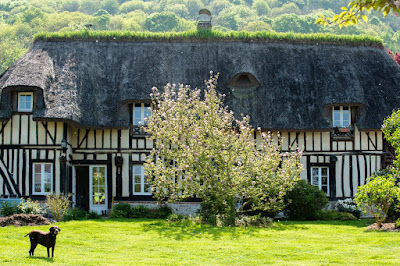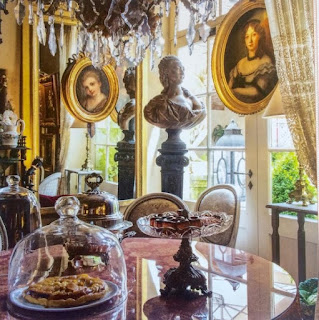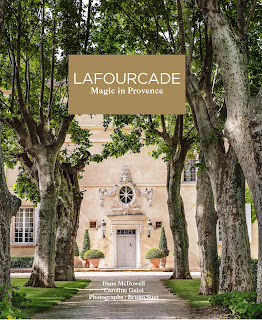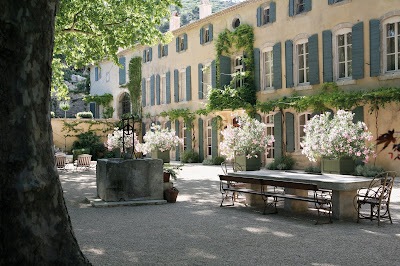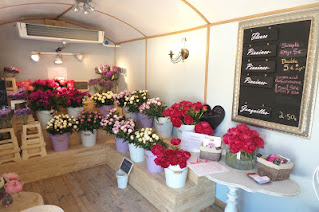























*All photo captions appear at the end of the text.
For anyone who asks me
where to eat in Provence, the Bistrot du Paradou has been my secret weapon
for years. (Around here the big question is not Is there a God? or What’s
the meaning of life? but rather, Where should we eat?) Not that it’s
secret by any means—Paradou is one of the most popular places around—but it’s a no
brainer, a guaranteed great experience at lunch or dinner, year round. The food at Paradou is hearty,
homemade, Provençal rustic, perfectly prepared, comforting...and superb. Plus,
it’s different from just about anywhere else...in the concept, service and
vibe. “We’ve never found anything like Paradou, anywhere in the world,” says my
friend Sandra Peskin, who calls it her go-to, her local, her home away from
home. When she has guests, Sandra always takes them or sends them to Paradou,
calling it “not a maybe but a must.” A couple years ago I had clients (a large
group of food pros from New Orleans) who ate at Paradou three times in one
week, asking me to cancel two other dinners in order to make that happen.
Nobody doesn’t like Paradou!
So we’re all pretty
excited that Paradou owner Vincent Quenin has finally opened his second
restaurant, this one in St. Remy. It’s called Le Bistrot de Saint-Remy and it’s
on the site of the former Cafe du Lezard, on avenue Gambetta or what locals
call “the bottom of the circle.” It opened for lunch and dinner on Monday.
While no restaurant
opening is easy, this one was probably harder than most. Renovation of the
space began last year but came to a screeching halt on March 14 (when Covid
shut down all non-essential business in France), and couldn’t resume until
June 2, the day our restaurant lock down was lifted. Vincent completely gutted
and rebuilt the interior, replicating the charming old Provençal ambiance of
its predecessor but with all new furniture, fixtures and equipment. “When you
come, you’ll remember what was here before—the decor is similar,” Vincent says. “But
everything was very very old. And now everything still feels old but
it’s completely clean and new.”
The new restaurant seats
40 inside and another 40 or so on the terrace.
Vincent’s partner in the
venture is Bastien Maltagliati, who was a server at Paradou for many
years...and who’s just as beloved around here as Vincent is. Bastien will run
the Bistrot and continue to run the Le Bar Divin next door, the popular St. Remy
hangout that he and Vincent also took over last year. “I wasn’t planning to buy
two places but when they both became available, I knew I should,” Vincent says.
“One bar, one restaurant, one big terrace...right next to each other....it made
sense.” Bastien and his father did much of the renovation work themselves.
The Bar Divin specializes in
beautiful, classic and creative cocktails made from fresh and unusual ingredients. The
beauty of the space is that the comfy terrace tables can easily be used for
drinks both before and after dinner. There’s live music on Friday and Saturday
nights and the crowd often spills onto the street.
Now that word is spreading that Vincent has opened in St. Remy, I notice the first thing people ask me is “Is it like Paradou?”
What they mean is, is it
that same wonderful food, at one set price for everything?
The answer is yes, sort
of...at least at dinner, where for €49 (compared to €60 at Paradou) you’ll get
a starter, main course, cheese course, dessert and all the wine you care to
drink. Coffee and bottled water are extra.
At Paradou, the main dish at dinner alternates between lamb and chicken. Here, it will change daily but choices will be limited: two starters, two mains (one fish and one
meat) and a handful of desserts. You can always call ahead to check what the
plat du jour is...and eventually there may be a weekly rotation just like at Paradou at lunch, where it’s usually tête de veau on Tuesday, chicken on Thursday, soupe au pistou and aïoli on Friday, lamb on Saturday, a fantastic cassoulet on Wednesday in winter... and so
forth.
Just like at Paradou, the
house wine in St. Remy is Château Mont-Redon from Châteauneuf-du-Pape (one of
the oldest estates in the Southern Rhône); it’s included in the set price at
dinner but not at lunch. They put the bottle on your table and replace it whenever
its empty. It’s nice to know you can have as much or little red, white or rosé as
you like...and for those who don’t know the wines of the region it eliminates
having to choose. Plus, people know that if it’s the house wine at Paradou, it’s
going to be good. For those who want a different label, there’s a full list and
you pay accordingly.
At lunch, Vincent
will veer further from the Paradou format, in the style of cuisine, the
timing and price. “That format, that country cooking, has been working at Paradou forever,”
he says, “and people don’t want that to change. They know what we serve and
that’s what they come for. Early on I tried to change the food there and my
regulars were like, ‘Vincent, what the f*ck?’”
But Vincent knew that
the “long lunch in the country” idea isn’t the best for a setting in the heart
of a busy village. “Here we need more
choice, something lighter, faster and cheaper,” he explains. “This menu’s designed
for people who are working in the bank, the insurance office, the shops...lighter,
fresher, more brasserie-style. We’ll do tomato mozzarella salad or a tomato
filled with straciatella,” he says, referring to the soup and not the ice
cream, of course. “We’re doing homemade gazpacho, a proper carpaccio, a proper
tartare we make ourselves.”
The lunch menu yesterday
also showed foie gras stuffed with truffles, a homemade terrine, quesadillas
(with tomato, pepper, avocado and cheddar), a croustillant of boudin noir and
those fabulous snails in garlic butter that everyone goes crazy for at Paradou.
Vincent loves the famous
Bouchon-style restaurants of Lyon and will pull some lunch dishes from those menus as well: duck
pâté, roast pork, sausages
and the like. A
three-course lunch (starter, main, dessert) is €29; cheese, wine and coffee are
extra. Or have a starter and main...or a main and dessert...with a glass of wine for €27.
If Paradou had a
signature dish it would have to be the spit-roasted poulet de Bresse...and
you’ll definitely find it here, circling in and out of rotation. My friend
Philippe Goninet calls Paradou “my Madeleine de Proust” because it reminds him
of family dinners as a kid. And he gives the chicken his ultimate compliment,
calling it “almost as good as my grandmother’s!”
Born and raised in
Arles, Vincent went to London after high school, primarily, he says, to learn
English. Then he lived for a while in Thailand before coming home to Provence
to stay. In 1997, he went to work at Paradou as a waiter, for then-owner
Jean-Louis Pons; the two became like father and son. When Jean-Louis decided to
retire in 2010, Vincent bought the restaurant...and has run it with his brother Pierre ever since. The two are extremely close.
Set in an 1832 relais
de poste or relais de diligence, the Bistrot du Paradou was
originally built to accommodate travellers with horses and stagecoaches, a
stopover on the route from Salon de Provence to Arles. “It was a place for
people to eat, sleep and dance,” Vincent says, “a crossroads, a rest along the
way. And later it was a village bar, a place to buy drinks and cigarettes, a
place where people were looked after. Pierre is more mystic than me
and has always said there’s a special energy there.”
Once he bought Paradou,
Vincent decided he better learn how to cook. “I realized if I ever lost my
chef, I’d be in serious trouble with no one to look after the kitchen,” he
remembers. “So I started to work with Marie (chef Marie-Laurence Souici.) I really
didn’t want to leave the front of the house—I loved the atmosphere in the
dining room—and back in the kitchen I was a bit sad! Luckily Marie never left but
I got used to the kitchen and stayed, working with her side by side.”
In St. Remy, Bastien is
the operating partner, overseeing both bar and restaurant. But until the new
restaurant finds its footing, Vincent will be at the stove, with a young
Paradou chef named Joan Laget as his #2. “We need to learn who our customers are, figure out what works best,” Vincent told me. “And of course I want to be there.”
And while Vincent gets St. Remy off the ground, Pierre's in Paradou running the show. "If he weren't there," Vincent says, "I could never have opened in St. Remy."
One of the many reasons
we all love Paradou is their “whatever, whenever” attitude. There’s one seating
a night, starting at 8 pm, so you stay as long as you like. You want to start
your meal inside then move out for dessert, coffee, Cognac, more wine? No
problem! You want seconds? If they have enough, you can. You want to bring in a
cake, send in a stripper, belt out a song, get up and dance? Seriously, nothing fazes anyone here. The servers are all fast, efficient, charming, funny, handsome and
unflappable.
“I’ve definitely got a
dream team,” Vincent says. “They always do a great job.”
Arriving at Paradou, you’ll smell the intoxicating aroma of good cooking wafting
from the open kitchen. And you’ll find a nicely dressed, refined-looking crowd: couples
on dates, families with kids, ladies who lunch, winemakers from down the road.
There’s often a celebrity or two, who everyone pretends to ignore. But soon any semblance of French-restaurant formality falls away as people start greeting
friends and making introductions, table hopping and switching seats, ambling in
and out to smoke, gesturing for more wine. The music gets louder, the staff
gets looser and that low-level buzz of polite conversation becomes more like a
full-on party.
While writing this story
I reached out to a few friends, all of them big Paradou fans, asking why they
love it so much. My friend Neassa Grennan
Hunt texted back quickly: “Can’t talk
now...I’m having dinner at Paradou!” I asked what was happening there and she
said “not much yet...but it’s early!”
The next day she came back with this: “Paradou is
our #1 restaurant by far and we tell all our clients it’s a must-do. But we
never go on a ‘school night’ because the next morning can definitely be a bit
rough!”
More than once my
friends and I were still hanging out on the terrace when the staff was
ready to head home after lunch service. They brought wine and water, said a
bientot, locked the doors and left. (Where else would that ever happen?) And
there were definitely times when we were still there when they came back to set
up for the evening.
When the summer crowds converge, Paradou is packed, inside and out. On a typical summer day they’ll serve 100 at
lunch and 100 at dinner...or more. In winter they’ll do half as many; everyone
eats together inside and the crowd is heavily local. Vincent tells me that winter is his favorite season and that's when he feels his restaurant is at its finest. “Winter
is when that energy Pierre talks about is the strongest,” he says.
One evening at dinner
this winter, Jean-Baptiste Bert—who worked at Paradou for many years but left
to open his own place a few miles down the road—came through the doorway and
the whole room burst into applause. Again, where else would something like that happen? (Read my story about Jean-Baptiste's Le Relais du Castelet here.)
Earlier that same winter evening
I saw Sandra Peskin hobble in, having had serious foot surgery just a few weeks
before. “This is my first night out!” she said, sounding sort of guilty. “But I
couldn’t wait any longer. I had to get out and of course it had to be Paradou! “
Just like at any
super-popular restaurant, getting a table at Paradou takes a bit of strategy. If
they happen to have space they’ll happily seat walk-ins but it’s always best to book. Reservations are by phone or Facebook messenger and you may have to
try more than once. And very soon at the Bistrot de Saint Remy, I'm sure it will be just the same.
“Paradou is my favorite restaurant on the planet,” says Sandra’s
husband Andrew, who could have easily bought the place with what he’s
spent there over the years. “The welcome, the escargot, the value for money,
the staff, the attention to detail, the buzz. I can’t tell you how excited I am
about Vincent opening in St Rémy.”
The Bistrot de Saint-Remy (This info updated March, 2023)
12 blvd. Gambetta
13210 St. Remy de Provence
To reserve: +33 (0)4-90-21-11-59.
Closed Tuesday and Wednesday.
Three-course lunch €39.
Four-course dinner with
wine €59.
The Bistrot du Paradou
57 ave de la Vallee des Baux
13520 Paradou
Lunch and dinner Tuesday through Saturday in
Summer; closed weekdays for dinner in Winter.
Four courses with wine: €55 at lunch, €60 at dinner.
Photos: (1) Bastien Maltagliati (left) and Vincent Quenin in St. Remy. Bastien is the operating partner and he oversees both the Bistrot de Saint Remy and the next-door Bar Divin. Vincent will be in the kitchen, at least for the summer, while his brother Pierre runs Paradou. (2) Seating in both the bar and the restaurant spills out onto the street. Pictured here, the new restaurant at dusk. (3) Before the restaurant opened this week, large "planchas" of nibbles, served in the bar and designed for sharing, could easily make a small meal. (4) The Divin crew with Bastien at the center back and Vincent's sous chef, Joan Laget, second from the right, in black. (5) Divin has happy hour with drink specials daily and live music on weekends. (6) I had to try the cocktail called Passion à Saint Remy: rum, lemon juice, passion fruit purée, fresh coriander and fresh ginger. Excellent! (7) Dining tables in St. Remy are well spaced to allow for distancing...and the servers are all in masks. (8-10) Lunch dishes include caviar of aubergine, pasta pesto with gambas roti and a dessert that looked amazing on a hot day. When I popped in today, they were also serving chicken with mashed potatoes and artichaux barigoule...and gazpacho. (11-15) Paradou's greatest hits will be part of the dinner rotation in St. Remy but not so much at lunch. Pictured: salade frisée with lardons, snails in garlic butter, soupe au pistou, Bresse chicken with fresh pasta and morel sauce, cassoulet. (16) Save room for cheese! Paradou's famous serve-yourself tray (with accoutrements) is plunked down on every table at lunch and dinner, always eliciting lots of ooh-la-la! (17) A battalion of bottles, open and ready for action. Mont-Redon is the house red, white and rosé at both restaurants. (18) Vincent and longtime Paradou chef Marie-Laurence Souici, photo courtesy of Via-Selection. (19, 20) The terrace at Paradou (ready for action in summer) and the dining room filling up in winter, when Vincent says the restaurant is its best version of itself. (21) Foodies love the kitchen table at Paradou. (22) Kids welcome! A pretty Provencal mural at Paradou, with high chairs at the ready. (23) Everyone loves Paradou aprons! These aren't for sale but newer ones, with the escargot logo, are €30 at the restaurant. (24) Vincent calls the staff at Paradou "a dream team." (Thanks to Michel Augsburger for letting me pull some of the photos above from his blog.)









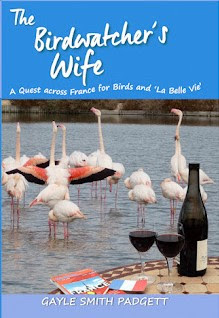






































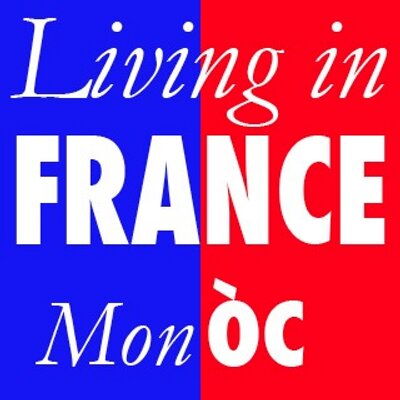











.jpg)



